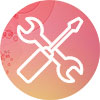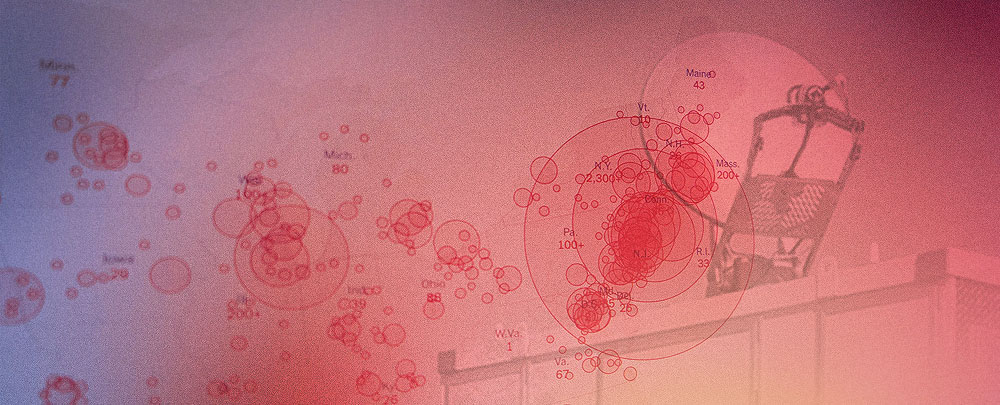The world looks different than it did a month ago. Tomorrow, it will look different again.
In spite of the unknowns and minute-by-minute changes of COVID-19, one thing remains constant… We have limitless opportunities to serve one another with care, compassion, and just the right amount of urgency. Here are a few ways you might use mobile assets to keep people safe, healthy, and connected through this public health crisis and beyond.
3 Strategies
1 // Go where the need is greatest. A mobile strategy (and the assets to support it) gets vital services and goods to the front lines. Having the ability to reach remote, socially-vulnerable, and other under-served areas is critically important.
2 // Manage risks and minimize harms. Mobile solutions allow you to more tightly control access, simplifying sanitation and reducing 1:1 contact. For remotely-operable assets, human touches can be vastly reduced or eliminated.
3 // Stay connected. When terrestrial networks are overloaded, mobile assets can be deployed quickly to build connectivity and restore communications. Organizations of all types need network resiliency, and mobile should be a piece of the puzzle.
Bonus Strategy // Plan for the future. Try to account for scenarios where the solutions you employ now can still be useful later. Also, consider that there might be overlap between COVID-19 and other emergencies. Wildfires, hurricanes, floods, and other disasters would exacerbate the current crisis and stress response systems even further.
10 Applications
![]() 1 // Comms and Connectivity. Healthcare teams and other crisis responders can’t afford compromised connectivity. Compact, trailer-based platforms like the Nomad TCT strengthen existing networks or bring them online where non exist. They can be managed remotely and run for days without human intervention. Vehicles like the Nomad TCV pack the comms horsepower of larger command platforms, while optimizing social distancing and reducing risk. HIPPAA and TCPA-compliant data storage and transfer comes standard.
1 // Comms and Connectivity. Healthcare teams and other crisis responders can’t afford compromised connectivity. Compact, trailer-based platforms like the Nomad TCT strengthen existing networks or bring them online where non exist. They can be managed remotely and run for days without human intervention. Vehicles like the Nomad TCV pack the comms horsepower of larger command platforms, while optimizing social distancing and reducing risk. HIPPAA and TCPA-compliant data storage and transfer comes standard.
![]() 2 // Screening and testing. Set up a self-contained facility or support drive-through screening and testing operations. Bring services to those most in need, including older and other at-risk populations. Decrease density at hospitals and other healthcare facilities.
2 // Screening and testing. Set up a self-contained facility or support drive-through screening and testing operations. Bring services to those most in need, including older and other at-risk populations. Decrease density at hospitals and other healthcare facilities.
![]() 3 // Lab work. In times of increased sampling and throughput, mobile labs reduce the load on fixed facilities. Sample transit time is also reduced, expediting diagnosis and moving patients to treatment more quickly when it’s needed.
3 // Lab work. In times of increased sampling and throughput, mobile labs reduce the load on fixed facilities. Sample transit time is also reduced, expediting diagnosis and moving patients to treatment more quickly when it’s needed.
![]() 4 // Treatment. Mobile solutions relieve healthcare facilities that are at or near capacity. From simple bed space to ICU, mobile solutions offer the same capabilities as fixed infrastructure, in a package that moves where it’s needed, is easier to contain and sanitize, and limits exposure by de-centralizing patients.
4 // Treatment. Mobile solutions relieve healthcare facilities that are at or near capacity. From simple bed space to ICU, mobile solutions offer the same capabilities as fixed infrastructure, in a package that moves where it’s needed, is easier to contain and sanitize, and limits exposure by de-centralizing patients.
![]() 5 // Pharmacy. In both hospital and retail applications, filling prescriptions where they’re generated speeds distribution, and for under-served and at-risk populations it might be the only way to deliver medication in a crisis. Mobile pharmacies designed with an eye to security and connectivity are just as capable as brick-and-mortar, with much greater flexibility.
5 // Pharmacy. In both hospital and retail applications, filling prescriptions where they’re generated speeds distribution, and for under-served and at-risk populations it might be the only way to deliver medication in a crisis. Mobile pharmacies designed with an eye to security and connectivity are just as capable as brick-and-mortar, with much greater flexibility.
![]() 6 // Decontamination. A mobile decon solution lets you rapidly deploy chemical washdown at scale exactly where it’s needed, protecting healthcare personnel and the public. The Nomad DRV is just one example of a purpose-built decontamination platform.
6 // Decontamination. A mobile decon solution lets you rapidly deploy chemical washdown at scale exactly where it’s needed, protecting healthcare personnel and the public. The Nomad DRV is just one example of a purpose-built decontamination platform.
![]() 7 // Coroner and Morgue Services. As brick-and-mortar facilities reach their limits, mobile assets can serve quickly at the places of greatest need. Right-sized, climate-controlled solutions enable investigations and certifications while protecting dignity.
7 // Coroner and Morgue Services. As brick-and-mortar facilities reach their limits, mobile assets can serve quickly at the places of greatest need. Right-sized, climate-controlled solutions enable investigations and certifications while protecting dignity.
![]() 8 // Food and supplies distribution. In a public health crisis — especially when people are quarantined or otherwise constrained — “everyday” distribution channels become stressed. Mobile solutions bring goods and services to the people.
8 // Food and supplies distribution. In a public health crisis — especially when people are quarantined or otherwise constrained — “everyday” distribution channels become stressed. Mobile solutions bring goods and services to the people.
![]() 9 // Administrative and office space. A mobile office provides all the comfort and connectivity of fixed infrastructure, protects existing staff, and accommodates the new and temporary workers needed in a crisis. Small workspace “pods” can be created and networked to limit 1:1 contact, while maintaining service levels. Insurance claims processing is one function that will be elevated during a public health response, and is perfectly-suited to mobile ops.
9 // Administrative and office space. A mobile office provides all the comfort and connectivity of fixed infrastructure, protects existing staff, and accommodates the new and temporary workers needed in a crisis. Small workspace “pods” can be created and networked to limit 1:1 contact, while maintaining service levels. Insurance claims processing is one function that will be elevated during a public health response, and is perfectly-suited to mobile ops.
 10 // Other essential services. Public utilities, telecom, transport, repair services… The gears that drive basic needs, quality of life, and commerce can’t be allowed to grind to a halt in a crisis. Every organization needs a resiliency plan. And for many, mobile solutions are at the heart. Nomad works with agencies and industries of all types, and we’re ready to serve you.
10 // Other essential services. Public utilities, telecom, transport, repair services… The gears that drive basic needs, quality of life, and commerce can’t be allowed to grind to a halt in a crisis. Every organization needs a resiliency plan. And for many, mobile solutions are at the heart. Nomad works with agencies and industries of all types, and we’re ready to serve you.
Mobile operations are playing a key role in COVID-19 response and mitigation, and in the coming months will be critical to recovery. Most importantly, the strategies and processes we put in place today will position all of us to respond more effectively to future crises.


